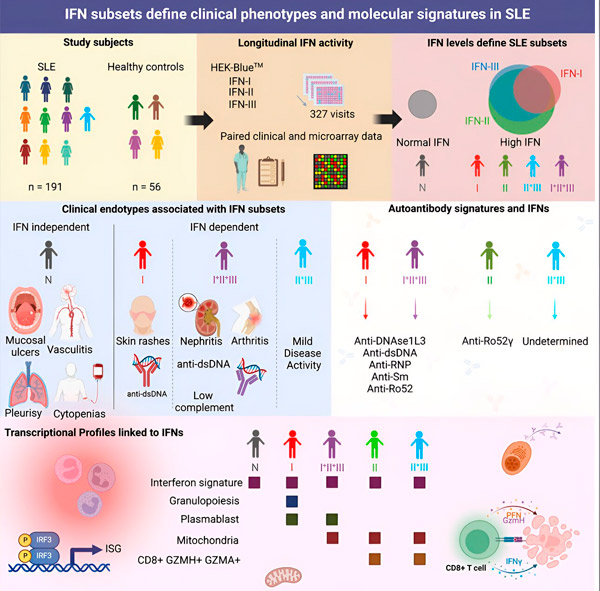Nye publikasjoner
Ny studie viser at visse kombinasjoner av antivirale proteiner er ansvarlige for lupussymptomer
Sist anmeldt: 02.07.2025

Alt iLive-innhold blir gjennomgått med medisin eller faktisk kontrollert for å sikre så mye faktuell nøyaktighet som mulig.
Vi har strenge retningslinjer for innkjøp og kun kobling til anerkjente medieområder, akademiske forskningsinstitusjoner og, når det er mulig, medisinsk peer-evaluerte studier. Merk at tallene i parenteser ([1], [2], etc.) er klikkbare koblinger til disse studiene.
Hvis du føler at noe av innholdet vårt er unøyaktig, utdatert eller ellers tvilsomt, velg det og trykk Ctrl + Enter.

I en ny studie sier forskere ved Johns Hopkins Medicine at de har funnet ut hvorfor lupussymptomer og alvorlighetsgrad varierer blant personer med den autoimmune sykdommen, som rammer opptil 1,5 millioner amerikanere. Teamet sier at det er et viktig skritt fremover i forståelsen av lupusbiologien og kan føre til endringer i hvordan leger behandler pasienter med sykdommen.
Den fullstendige rapporten, publisert i tidsskriftet Cell Reports Medicine, konkluderer med at spesifikke kombinasjoner og forhøyede nivåer av immunsystemproteiner kjent som interferoner er assosiert med visse lupussymptomer, som hudutslett, nyrebetennelse og leddsmerter.
Interferoner bidrar vanligvis til å bekjempe infeksjon eller sykdom, men ved lupus er de overaktive og forårsaker utbredt betennelse og skade. Studien viser også at andre vanlige lupussymptomer ikke kan forklares med forhøyede interferonnivåer.
«Vi har lært i årevis at interferoner spiller en rolle i lupus», sier hovedforfatter av studien og revmatolog Dr. Felipe Andrade, assisterende professor i medisin ved Johns Hopkins Medicine. Han forklarer at studien startet med spørsmål om hvorfor noen lupusbehandlinger ikke fungerte for noen pasienter.
«Vi så tilfeller der pasientens tilstand overraskende nok ikke ble bedre – vi lurte på om visse grupper av interferoner var involvert.»
Noen lupusbehandlinger retter seg mot en spesifikk gruppe interferoner kjent som interferon I. Under kliniske studier av disse behandlingene observerte teamet at noen pasienter ikke ble bedre til tross for at genetiske tester viste høye nivåer av interferon I før behandling, eller det eksperter kaller en høy interferonsignatur. Teamet antok at to andre grupper interferoner, interferon II og interferon III, kunne være ansvarlige for disse dårlige behandlingsresponsene.
For å finne ut av dette, undersøkte teamet hvordan ulike kombinasjoner av interferoner I, II eller III og deres overaktivitet kan manifestere seg hos personer med lupus. Forskerne tok 341 prøver fra 191 deltakere for å bestemme aktiviteten til de tre gruppene av interferoner, og brukte humane cellelinjer spesielt konstruert for å reagere på tilstedeværelsen av hver spesifikke gruppe av interferoner for å analysere prøvene.
Gjennom denne prosessen fant forskerne ut at de fleste deltakerne falt i fire kategorier: de som bare hadde forhøyet interferon I; de som hadde en kombinasjon av forhøyede interferoner I, II og III; de som hadde en kombinasjon av forhøyede interferoner II og III; eller de som hadde normale interferonnivåer.

Kilde: Cell Reports Medicine (2024). DOI: 10.1016/j.xcrm.2024.101569
Forskerne kunne bruke disse dataene til også å etablere flere koblinger mellom disse interferonkombinasjonene og lupussymptomer. Hos de med forhøyet interferon I var lupus primært assosiert med symptomer som påvirket huden, som utslett eller magesår. Deltakere med forhøyede nivåer av interferon I, II og III hadde de mest alvorlige lupusmanifestasjonene, ofte med betydelig skade på organer som nyrer.
Imidlertid var ikke alle lupussymptomer assosiert med forhøyede interferoner. Blodpropper og lavt antall blodplater, som også påvirker koagulasjonen, var ikke assosiert med forhøyede nivåer av interferoner I, II eller III.
Forskerne mener dette indikerer at både interferonavhengige og andre biologiske mekanismer er involvert i denne komplekse sykdommen. Studien fant også at genetisk testing av gener assosiert med disse gruppene av interferoner, eller interferonsignaturer, ikke alltid indikerer forhøyede interferonnivåer. De planlegger å undersøke dette i fremtidige studier.
«Studien vår viste at disse interferongruppene ikke er isolerte; de fungerer som et team ved lupus og kan gi pasienter ulike manifestasjoner av sykdommen», sier revmatolog Dr. Eduardo Gomez-Bañuelos, assisterende professor i medisin ved Johns Hopkins Medicine og studiens førsteforfatter. Å vurdere en pasients forhøyede interferonkombinasjoner gir en bedre forståelse av hvordan de kan reagere på behandling og lar leger gruppere dem i kliniske undertyper av lupus, forklarer Gomez-Bañuelos.
